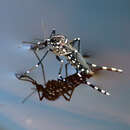en
names in breadcrumbs


Aedes is a genus of mosquitoes originally found in tropical and subtropical zones, but now found on all continents except Antarctica. Some species have been spread by human activity: Aedes albopictus, a particularly invasive species, was spread to the New World, including the United States, in the 1980s, by the used-tire trade.[1]
First described and named by German entomologist Johann Wilhelm Meigen in 1818, the generic name comes from the Ancient Greek ἀηδής, aēdēs, meaning "unpleasant" or "odious". The type species for Aedes is Aedes cinereus.[2]

The genus was named by Johann Wilhelm Meigen in 1818. The generic name comes from the Ancient Greek ἀηδής, aēdēs, meaning "unpleasant"[4] or "odious".
As historically defined, the genus contains over 700 species (see the list of Aedes species). The genus has been divided into several subgenera (Aedes, Diceromyia, Finlaya, Stegomyia, etc.), most of which have been recently treated by some authorities as full genera.[5] The classification was revised in 2009.[6]
Aedes mosquitoes are visually distinctive because they have noticeable black and white markings on their bodies and legs. Unlike most other mosquitoes, they are active and bite only during the daytime. The peak biting periods are early in the morning and in the evening before dusk.[7][8]
The genus contains 28 species that are not placed in a further subgenus:[9]
Members of the genus Aedes are known vectors for numerous viral infections, including dengue fever, yellow fever, the Zika virus,[10] and chikungunya, which are transmitted by species in the subgenus Stegomyia, and by A. aegypti and A. albopictus.[11] Infections with these viruses are typically accompanied by a fever, and in some cases, encephalitis, which can lead to death. A vaccine to provide protection from yellow fever exists, and measures to prevent mosquito bites include insecticides such as DDT, mosquito traps, insect repellents, mosquito nets, and pest control using genetically modified insects.[12] In Polynesia, the species Aedes polynesiensis is responsible for the transmission of human lymphatic filariasis.
Aedes can be detected and monitored by ovitraps.
The genome of the yellow fever mosquito (Aedes aegypti) was sequenced by the Broad Institute and the Institute for Genomic Research. The initial assembly was released in August 2005; a draft sequence of the genome and preliminary analysis was published in June 2007.[13] The annotated genome is available at VectorBase.[14] An updated and improved version of the Aedes aegypti genome was released in 2018.[15]
Aedes is a genus of mosquitoes originally found in tropical and subtropical zones, but now found on all continents except Antarctica. Some species have been spread by human activity: Aedes albopictus, a particularly invasive species, was spread to the New World, including the United States, in the 1980s, by the used-tire trade.
First described and named by German entomologist Johann Wilhelm Meigen in 1818, the generic name comes from the Ancient Greek ἀηδής, aēdēs, meaning "unpleasant" or "odious". The type species for Aedes is Aedes cinereus.